wiring CHEVROLET CAVALIER 2004 3.G Owners Manual
[x] Cancel search | Manufacturer: CHEVROLET, Model Year: 2004, Model line: CAVALIER, Model: CHEVROLET CAVALIER 2004 3.GPages: 354, PDF Size: 2.42 MB
Page 74 of 354
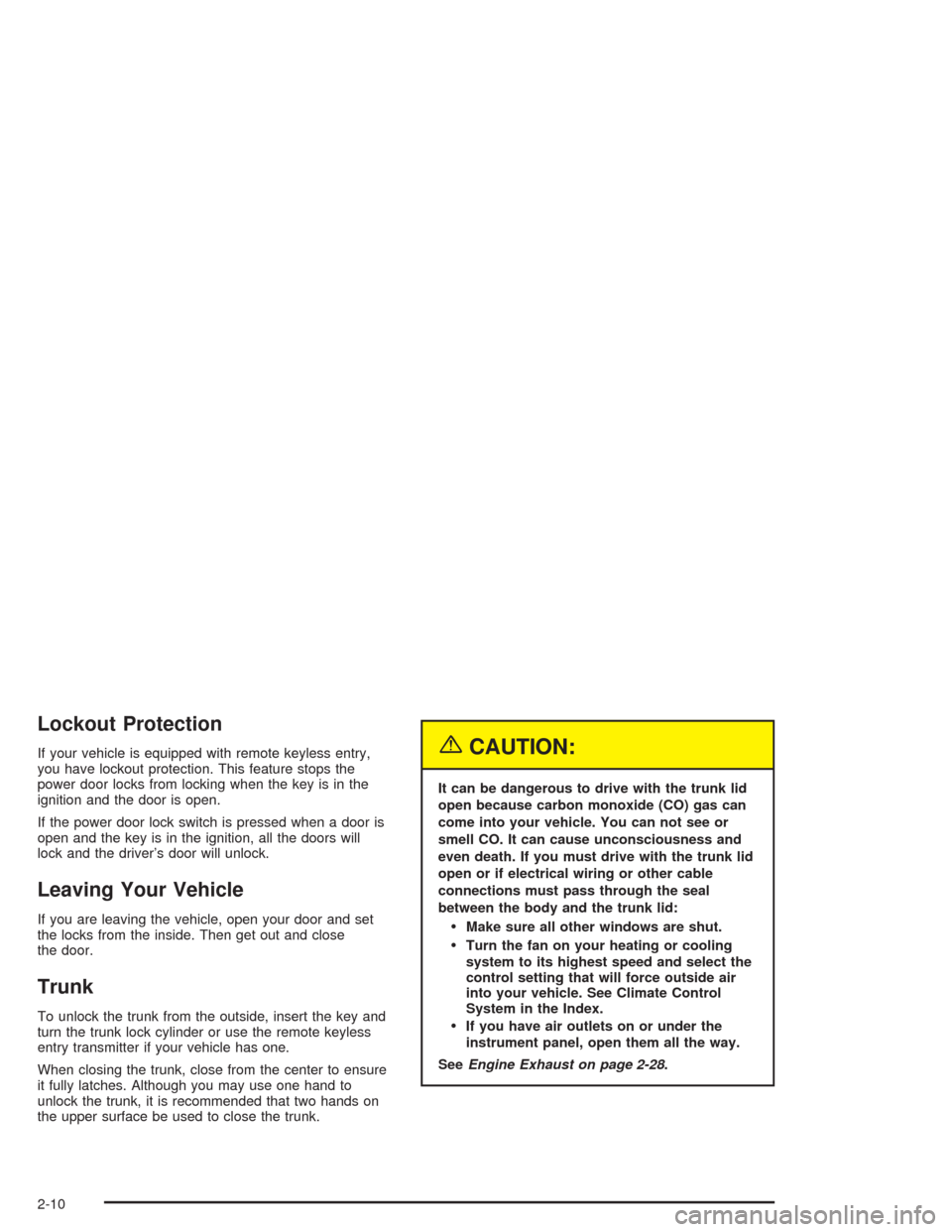
Lockout Protection
If your vehicle is equipped with remote keyless entry,
you have lockout protection. This feature stops the
power door locks from locking when the key is in the
ignition and the door is open.
If the power door lock switch is pressed when a door is
open and the key is in the ignition, all the doors will
lock and the driver’s door will unlock.
Leaving Your Vehicle
If you are leaving the vehicle, open your door and set
the locks from the inside. Then get out and close
the door.
Trunk
To unlock the trunk from the outside, insert the key and
turn the trunk lock cylinder or use the remote keyless
entry transmitter if your vehicle has one.
When closing the trunk, close from the center to ensure
it fully latches. Although you may use one hand to
unlock the trunk, it is recommended that two hands on
the upper surface be used to close the trunk.
{CAUTION:
It can be dangerous to drive with the trunk lid
open because carbon monoxide (CO) gas can
come into your vehicle. You can not see or
smell CO. It can cause unconsciousness and
even death. If you must drive with the trunk lid
open or if electrical wiring or other cable
connections must pass through the seal
between the body and the trunk lid:
Make sure all other windows are shut.
Turn the fan on your heating or cooling
system to its highest speed and select the
control setting that will force outside air
into your vehicle. See Climate Control
System in the Index.
If you have air outlets on or under the
instrument panel, open them all the way.
SeeEngine Exhaust on page 2-28.
2-10
Page 121 of 354
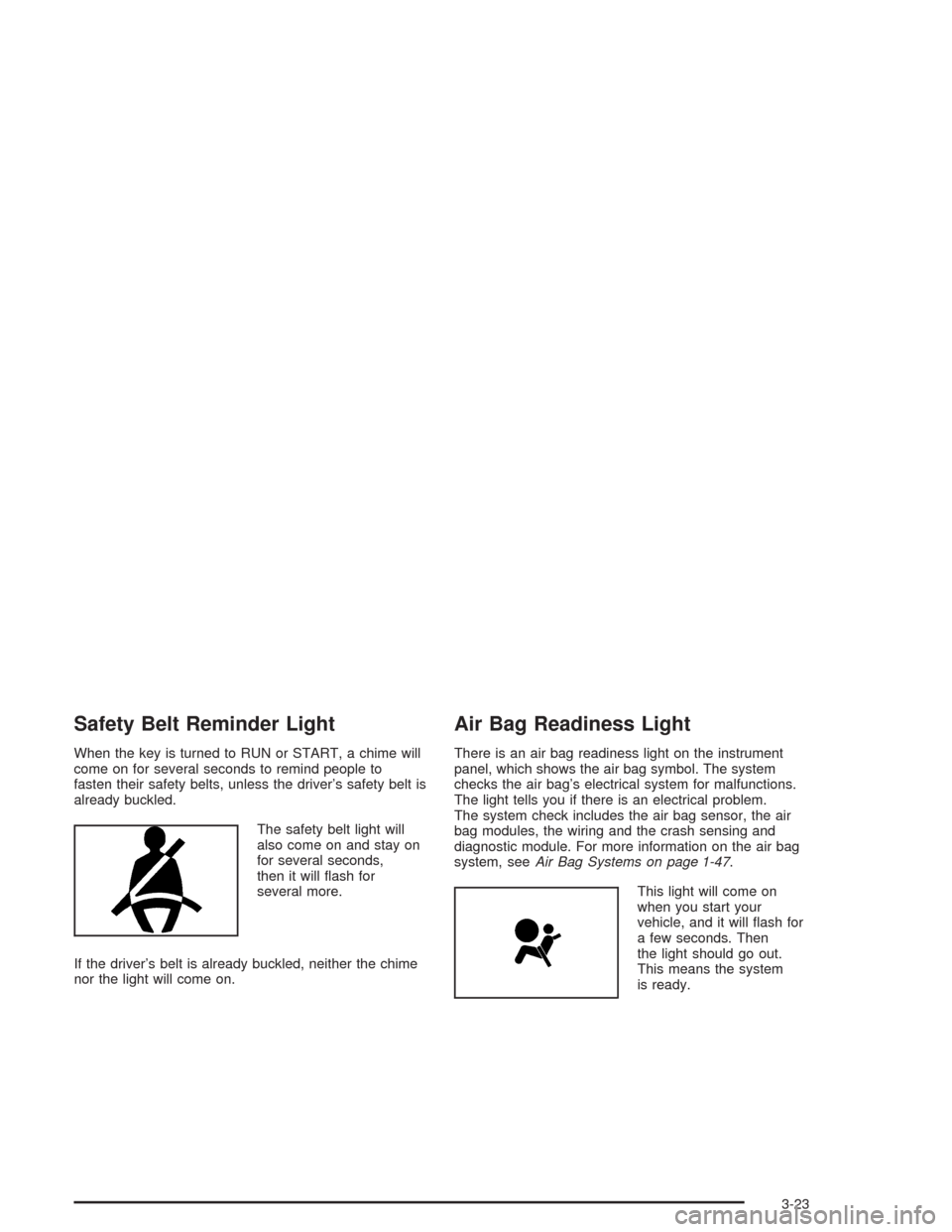
Safety Belt Reminder Light
When the key is turned to RUN or START, a chime will
come on for several seconds to remind people to
fasten their safety belts, unless the driver’s safety belt is
already buckled.
The safety belt light will
also come on and stay on
for several seconds,
then it will �ash for
several more.
If the driver’s belt is already buckled, neither the chime
nor the light will come on.
Air Bag Readiness Light
There is an air bag readiness light on the instrument
panel, which shows the air bag symbol. The system
checks the air bag’s electrical system for malfunctions.
The light tells you if there is an electrical problem.
The system check includes the air bag sensor, the air
bag modules, the wiring and the crash sensing and
diagnostic module. For more information on the air bag
system, seeAir Bag Systems on page 1-47.
This light will come on
when you start your
vehicle, and it will �ash for
a few seconds. Then
the light should go out.
This means the system
is ready.
3-23
Page 207 of 354
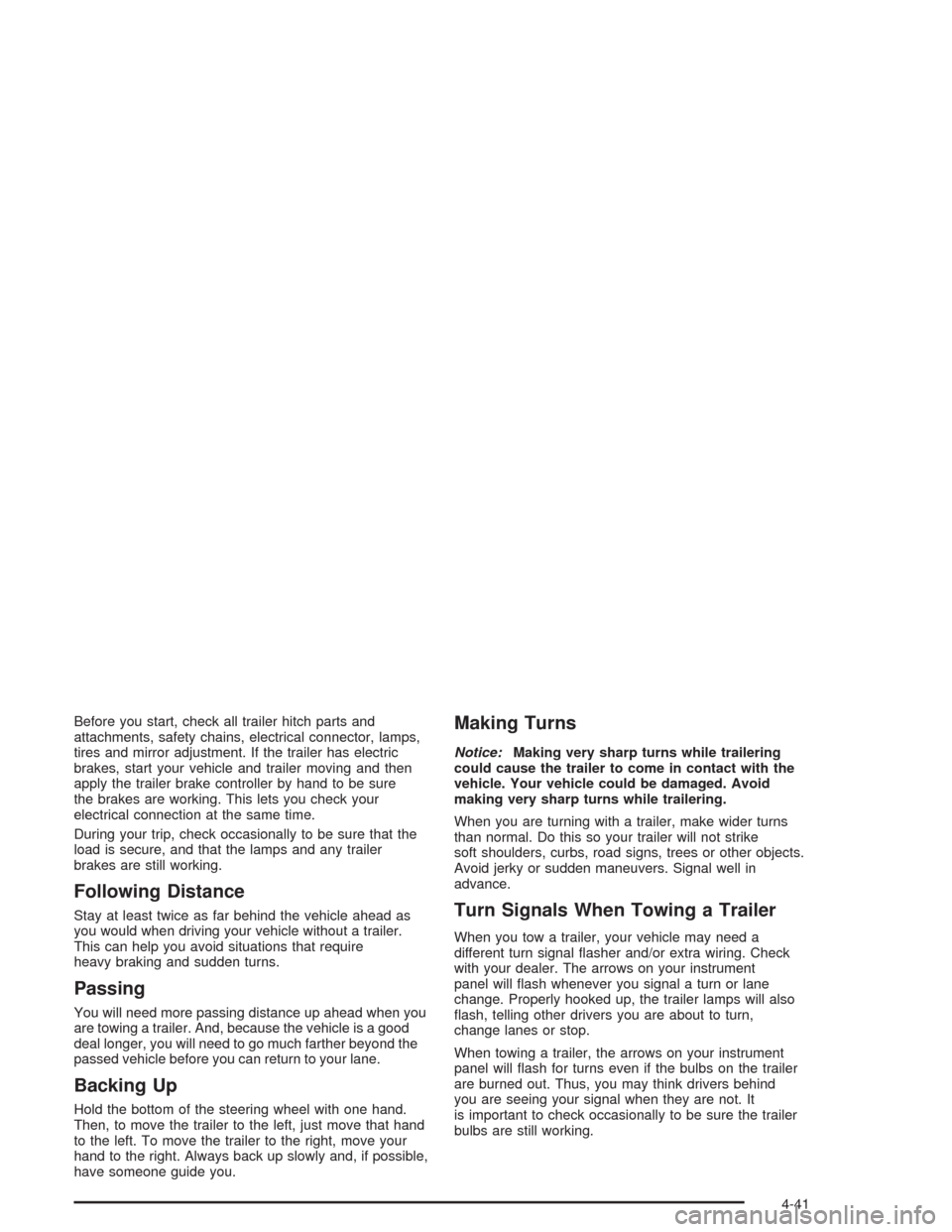
Before you start, check all trailer hitch parts and
attachments, safety chains, electrical connector, lamps,
tires and mirror adjustment. If the trailer has electric
brakes, start your vehicle and trailer moving and then
apply the trailer brake controller by hand to be sure
the brakes are working. This lets you check your
electrical connection at the same time.
During your trip, check occasionally to be sure that the
load is secure, and that the lamps and any trailer
brakes are still working.
Following Distance
Stay at least twice as far behind the vehicle ahead as
you would when driving your vehicle without a trailer.
This can help you avoid situations that require
heavy braking and sudden turns.
Passing
You will need more passing distance up ahead when you
are towing a trailer. And, because the vehicle is a good
deal longer, you will need to go much farther beyond the
passed vehicle before you can return to your lane.
Backing Up
Hold the bottom of the steering wheel with one hand.
Then, to move the trailer to the left, just move that hand
to the left. To move the trailer to the right, move your
hand to the right. Always back up slowly and, if possible,
have someone guide you.
Making Turns
Notice:Making very sharp turns while trailering
could cause the trailer to come in contact with the
vehicle. Your vehicle could be damaged. Avoid
making very sharp turns while trailering.
When you are turning with a trailer, make wider turns
than normal. Do this so your trailer will not strike
soft shoulders, curbs, road signs, trees or other objects.
Avoid jerky or sudden maneuvers. Signal well in
advance.
Turn Signals When Towing a Trailer
When you tow a trailer, your vehicle may need a
different turn signal �asher and/or extra wiring. Check
with your dealer. The arrows on your instrument
panel will �ash whenever you signal a turn or lane
change. Properly hooked up, the trailer lamps will also
�ash, telling other drivers you are about to turn,
change lanes or stop.
When towing a trailer, the arrows on your instrument
panel will �ash for turns even if the bulbs on the trailer
are burned out. Thus, you may think drivers behind
you are seeing your signal when they are not. It
is important to check occasionally to be sure the trailer
bulbs are still working.
4-41
Page 212 of 354
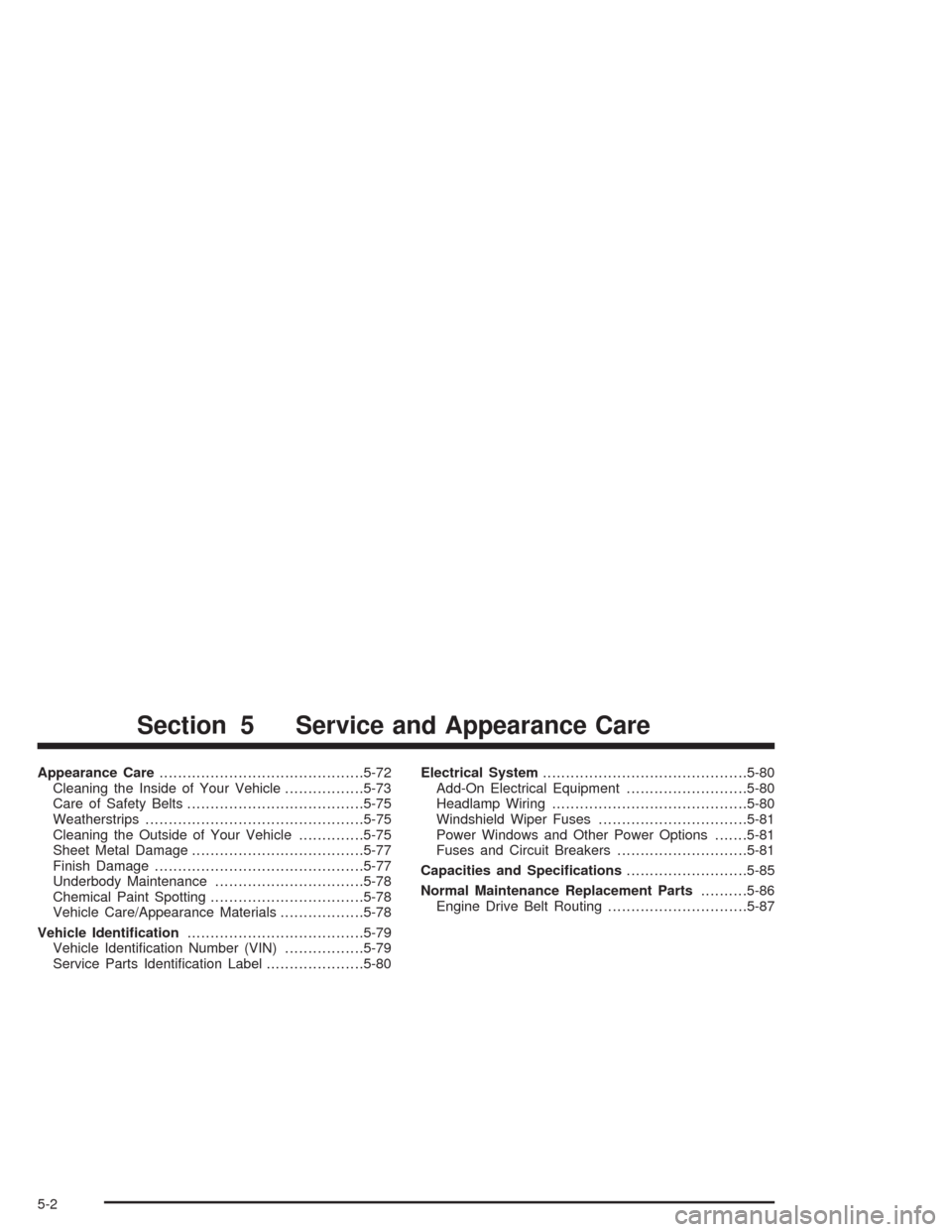
Appearance Care............................................5-72
Cleaning the Inside of Your Vehicle.................5-73
Care of Safety Belts......................................5-75
Weatherstrips...............................................5-75
Cleaning the Outside of Your Vehicle..............5-75
Sheet Metal Damage.....................................5-77
Finish Damage.............................................5-77
Underbody Maintenance................................5-78
Chemical Paint Spotting.................................5-78
Vehicle Care/Appearance Materials..................5-78
Vehicle Identi�cation......................................5-79
Vehicle Identi�cation Number (VIN).................5-79
Service Parts Identi�cation Label.....................5-80Electrical System............................................5-80
Add-On Electrical Equipment..........................5-80
Headlamp Wiring..........................................5-80
Windshield Wiper Fuses................................5-81
Power Windows and Other Power Options.......5-81
Fuses and Circuit Breakers............................5-81
Capacities and Speci�cations..........................5-85
Normal Maintenance Replacement Parts..........5-86
Engine Drive Belt Routing..............................5-87
Section 5 Service and Appearance Care
5-2
Page 290 of 354
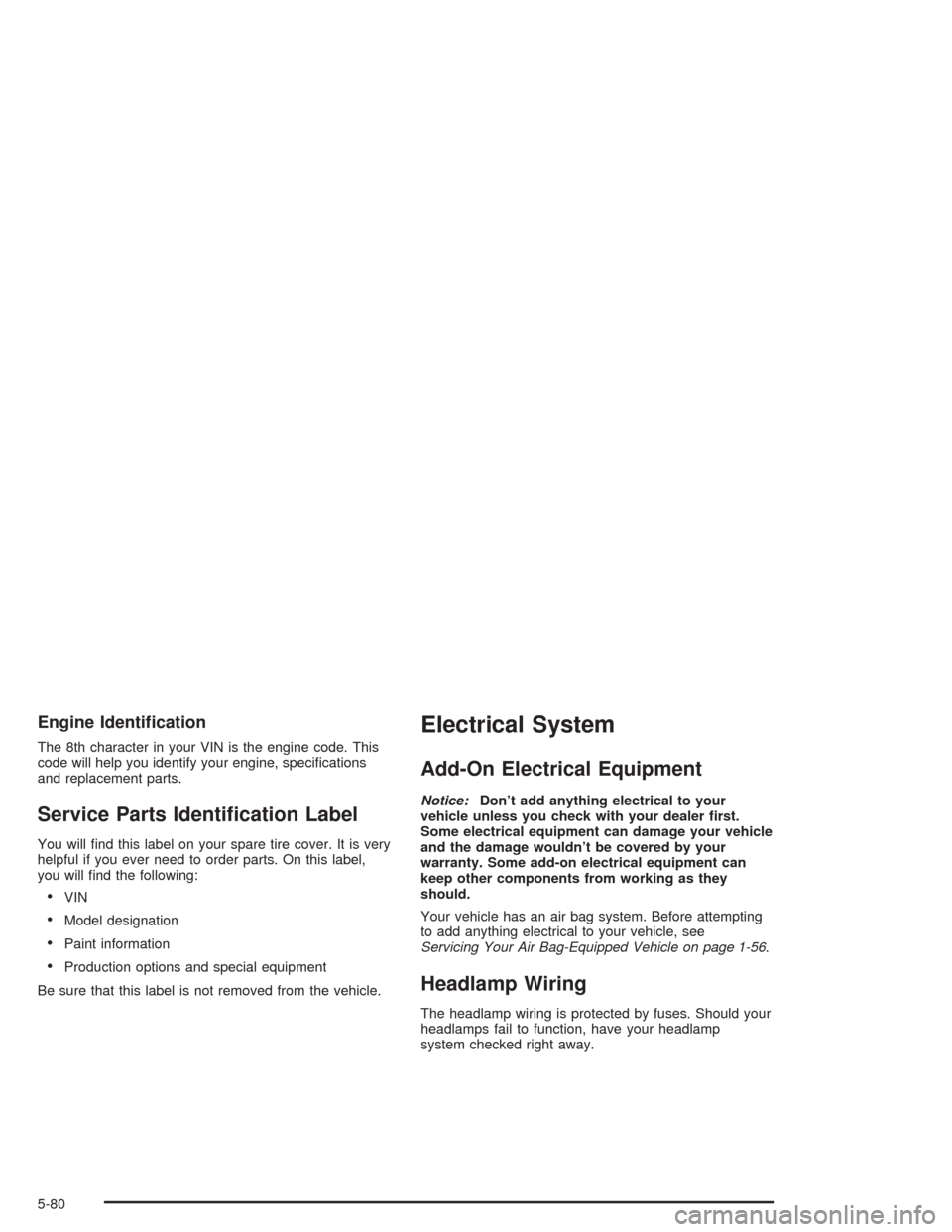
Engine Identi�cation
The 8th character in your VIN is the engine code. This
code will help you identify your engine, speci�cations
and replacement parts.
Service Parts Identi�cation Label
You will �nd this label on your spare tire cover. It is very
helpful if you ever need to order parts. On this label,
you will �nd the following:
VIN
Model designation
Paint information
Production options and special equipment
Be sure that this label is not removed from the vehicle.
Electrical System
Add-On Electrical Equipment
Notice:Don’t add anything electrical to your
vehicle unless you check with your dealer �rst.
Some electrical equipment can damage your vehicle
and the damage wouldn’t be covered by your
warranty. Some add-on electrical equipment can
keep other components from working as they
should.
Your vehicle has an air bag system. Before attempting
to add anything electrical to your vehicle, see
Servicing Your Air Bag-Equipped Vehicle on page 1-56.
Headlamp Wiring
The headlamp wiring is protected by fuses. Should your
headlamps fail to function, have your headlamp
system checked right away.
5-80
Page 291 of 354
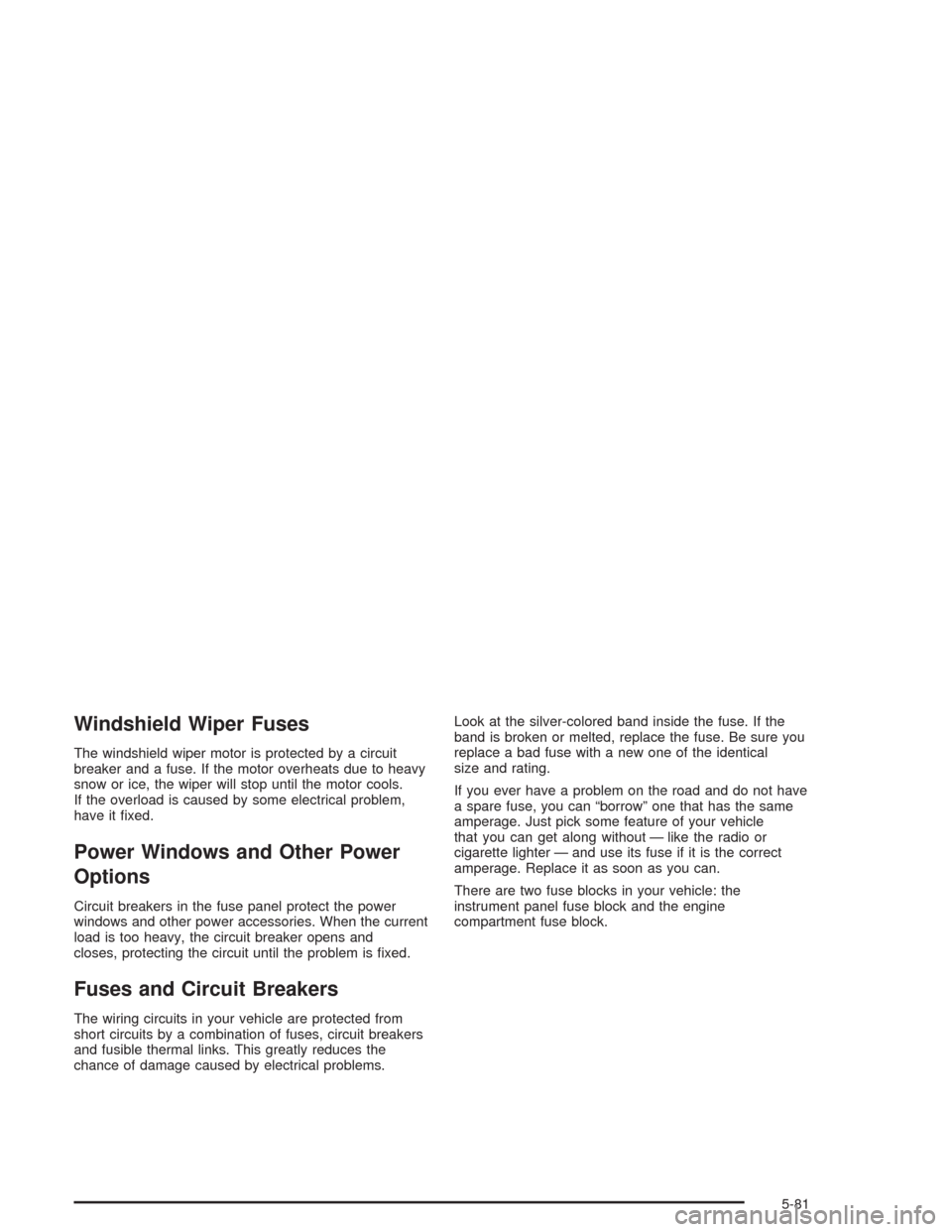
Windshield Wiper Fuses
The windshield wiper motor is protected by a circuit
breaker and a fuse. If the motor overheats due to heavy
snow or ice, the wiper will stop until the motor cools.
If the overload is caused by some electrical problem,
have it �xed.
Power Windows and Other Power
Options
Circuit breakers in the fuse panel protect the power
windows and other power accessories. When the current
load is too heavy, the circuit breaker opens and
closes, protecting the circuit until the problem is �xed.
Fuses and Circuit Breakers
The wiring circuits in your vehicle are protected from
short circuits by a combination of fuses, circuit breakers
and fusible thermal links. This greatly reduces the
chance of damage caused by electrical problems.Look at the silver-colored band inside the fuse. If the
band is broken or melted, replace the fuse. Be sure you
replace a bad fuse with a new one of the identical
size and rating.
If you ever have a problem on the road and do not have
a spare fuse, you can “borrow” one that has the same
amperage. Just pick some feature of your vehicle
that you can get along without — like the radio or
cigarette lighter — and use its fuse if it is the correct
amperage. Replace it as soon as you can.
There are two fuse blocks in your vehicle: the
instrument panel fuse block and the engine
compartment fuse block.
5-81
Page 343 of 354
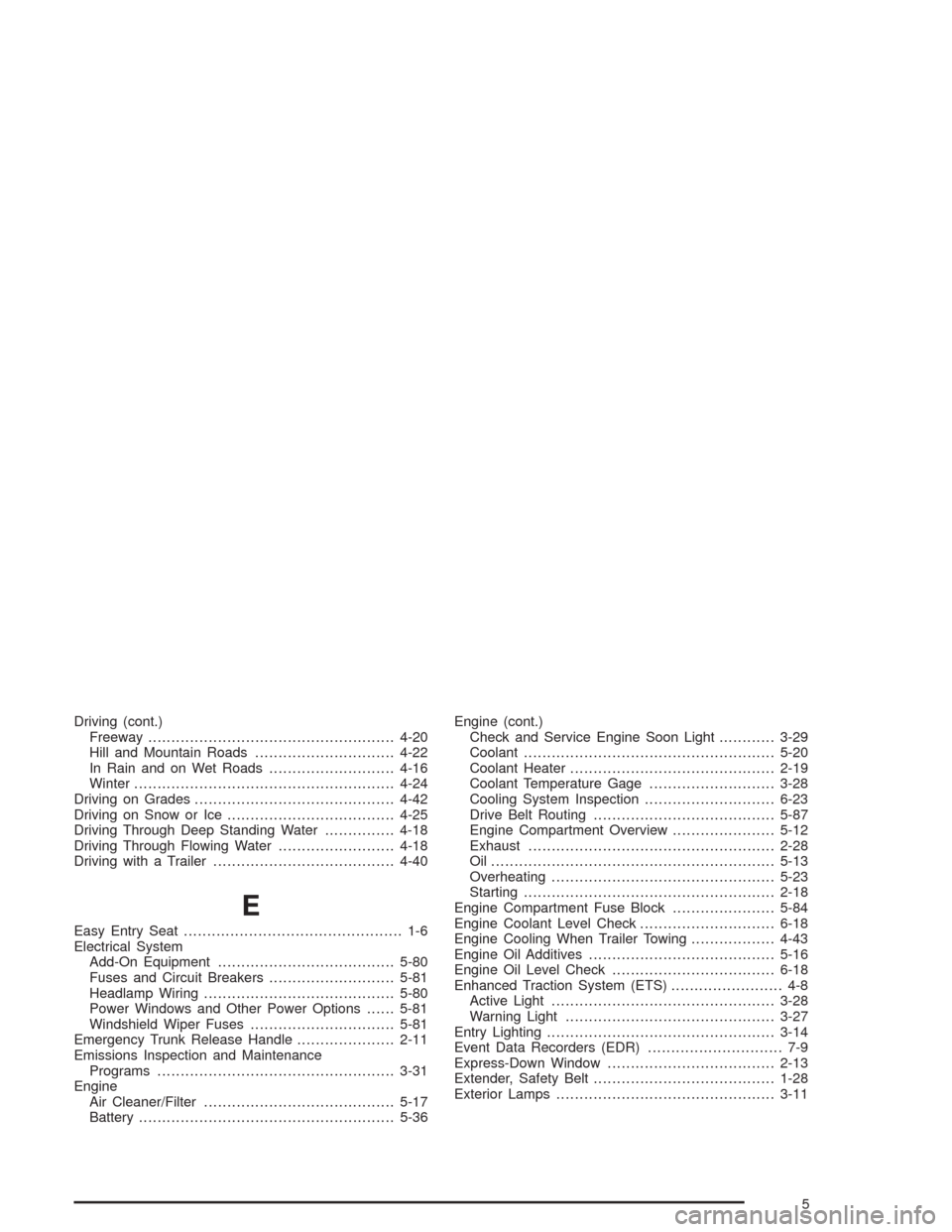
Driving (cont.)
Freeway.....................................................4-20
Hill and Mountain Roads..............................4-22
In Rain and on Wet Roads...........................4-16
Winter........................................................4-24
Driving on Grades...........................................4-42
Driving on Snow or Ice....................................4-25
Driving Through Deep Standing Water...............4-18
Driving Through Flowing Water.........................4-18
Driving with a Trailer.......................................4-40
E
Easy Entry Seat............................................... 1-6
Electrical System
Add-On Equipment......................................5-80
Fuses and Circuit Breakers...........................5-81
Headlamp Wiring.........................................5-80
Power Windows and Other Power Options......5-81
Windshield Wiper Fuses...............................5-81
Emergency Trunk Release Handle.....................2-11
Emissions Inspection and Maintenance
Programs...................................................3-31
Engine
Air Cleaner/Filter.........................................5-17
Battery.......................................................5-36Engine (cont.)
Check and Service Engine Soon Light............3-29
Coolant......................................................5-20
Coolant Heater............................................2-19
Coolant Temperature Gage...........................3-28
Cooling System Inspection............................6-23
Drive Belt Routing.......................................5-87
Engine Compartment Overview......................5-12
Exhaust.....................................................2-28
Oil .............................................................5-13
Overheating................................................5-23
Starting......................................................2-18
Engine Compartment Fuse Block......................5-84
Engine Coolant Level Check.............................6-18
Engine Cooling When Trailer Towing..................4-43
Engine Oil Additives........................................5-16
Engine Oil Level Check...................................6-18
Enhanced Traction System (ETS)........................ 4-8
Active Light................................................3-28
Warning Light.............................................3-27
Entry Lighting.................................................3-14
Event Data Recorders (EDR)............................. 7-9
Express-Down Window....................................2-13
Extender, Safety Belt.......................................1-28
Exterior Lamps...............................................3-11
5
Page 345 of 354
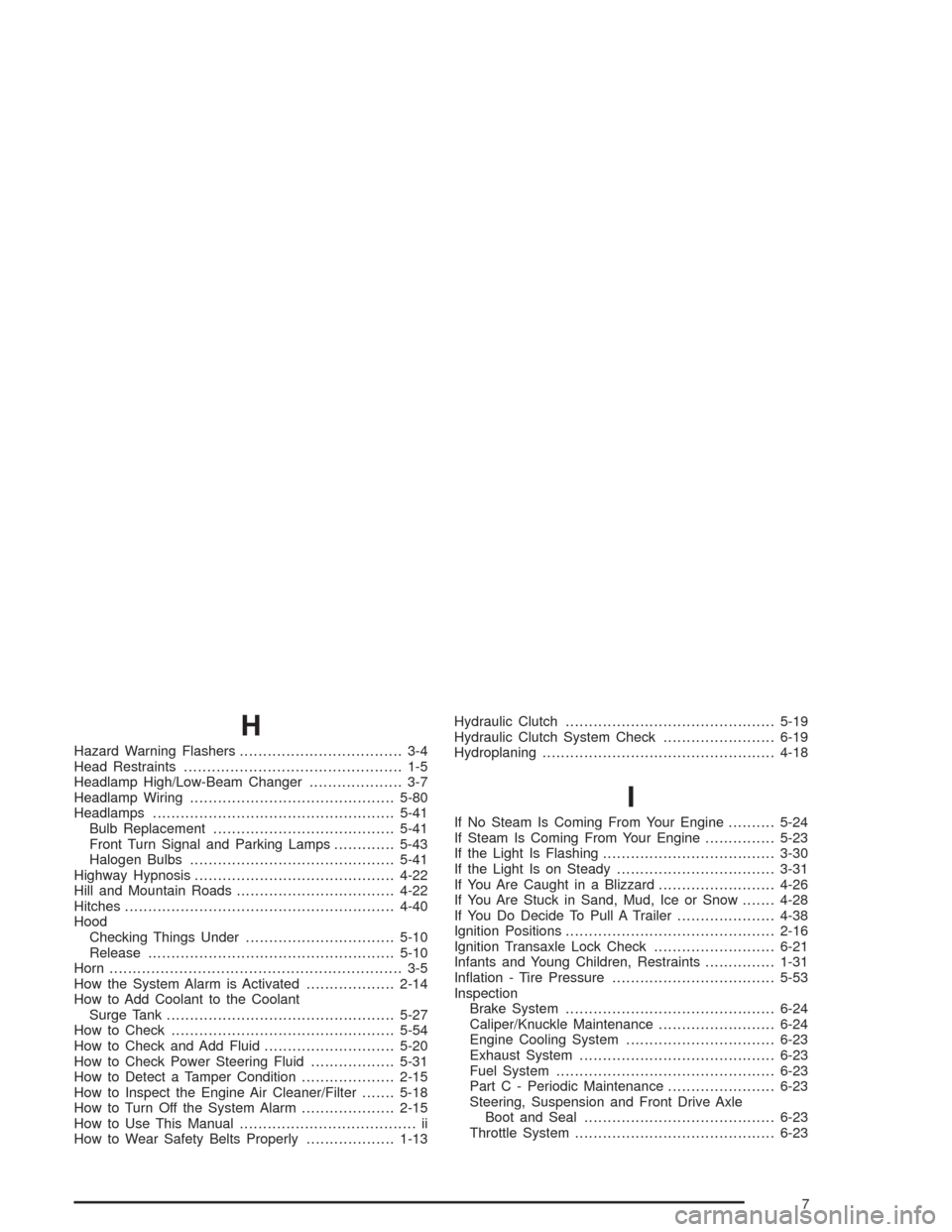
H
Hazard Warning Flashers................................... 3-4
Head Restraints............................................... 1-5
Headlamp High/Low-Beam Changer.................... 3-7
Headlamp Wiring............................................5-80
Headlamps....................................................5-41
Bulb Replacement.......................................5-41
Front Turn Signal and Parking Lamps.............5-43
Halogen Bulbs............................................5-41
Highway Hypnosis...........................................4-22
Hill and Mountain Roads..................................4-22
Hitches..........................................................4-40
Hood
Checking Things Under................................5-10
Release.....................................................5-10
Horn............................................................... 3-5
How the System Alarm is Activated...................2-14
How to Add Coolant to the Coolant
Surge Tank.................................................5-27
How to Check................................................5-54
How to Check and Add Fluid............................5-20
How to Check Power Steering Fluid..................5-31
How to Detect a Tamper Condition....................2-15
How to Inspect the Engine Air Cleaner/Filter.......5-18
How to Turn Off the System Alarm....................2-15
How to Use This Manual...................................... ii
How to Wear Safety Belts Properly...................1-13Hydraulic Clutch.............................................5-19
Hydraulic Clutch System Check........................6-19
Hydroplaning..................................................4-18
I
If No Steam Is Coming From Your Engine..........5-24
If Steam Is Coming From Your Engine...............5-23
If the Light Is Flashing.....................................3-30
If the Light Is on Steady..................................3-31
If You Are Caught in a Blizzard.........................4-26
If You Are Stuck in Sand, Mud, Ice or Snow.......4-28
If You Do Decide To Pull A Trailer.....................4-38
Ignition Positions.............................................2-16
Ignition Transaxle Lock Check..........................6-21
Infants and Young Children, Restraints...............1-31
In�ation - Tire Pressure...................................5-53
Inspection
Brake System.............................................6-24
Caliper/Knuckle Maintenance.........................6-24
Engine Cooling System................................6-23
Exhaust System..........................................6-23
Fuel System...............................................6-23
Part C - Periodic Maintenance.......................6-23
Steering, Suspension and Front Drive Axle
Boot and Seal.........................................6-23
Throttle System...........................................6-23
7